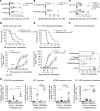Targeting self and neo-epitopes with a modular self-adjuvanting cancer vaccine
- PMID: 31013258
- PMCID: PMC6629093
- DOI: 10.1172/jci.insight.127305
Targeting self and neo-epitopes with a modular self-adjuvanting cancer vaccine
Abstract
Induction of a potent CD4 and CD8 T-cell response against tumor-specific and tumor-associated antigen is critical for eliminating tumor cells. Recent vaccination strategies have been hampered by an inefficacious and low amplitude immune response. Here we describe a self-adjuvanted chimeric protein vaccine platform to address these challenges, characterized by a multidomain construction incorporating (i) a cell penetrating peptide (CPP) allowing internalization of several multiantigenic Major Histocompatibility Complex (MHC)-restricted peptides within (ii) the multiantigenic domain (Mad) and (iii) a TLR2/4 agonist domain (TLRag). Functionality of the resulting chimeric protein is based on the combined effect of the above-mentioned three different domains for simultaneous activation of antigen presenting cells and antigen cross-presentation, leading to an efficacious multiantigenic and multiallelic cellular immune response. Helper and cytotoxic T-cell responses were observed against model-, neo- and self-antigens, and were highly potent in several murine tumor models. The safety and the immunogenicity of a human vaccine candidate designed for colorectal cancer treatment was demonstrated in a non-human primate model. This newly engineered therapeutic vaccine approach is promising for the treatment of poorly infiltrated tumors that do not respond to currently marketed immunotherapies.
Keywords: Cellular immune response; Colorectal cancer; Immunotherapy; Oncology; Vaccines.
Conflict of interest statement
Figures






Similar articles
-
Tumour-specific CTL response requiring interactions of four different cell types and recognition of MHC class I and class II restricted tumour antigens.Immunol Cell Biol. 1993 Aug;71 ( Pt 4):311-26. doi: 10.1038/icb.1993.36. Immunol Cell Biol. 1993. PMID: 7901150
-
Novel Cell-Penetrating Peptide-Based Vaccine Induces Robust CD4+ and CD8+ T Cell-Mediated Antitumor Immunity.Cancer Res. 2015 Aug 1;75(15):3020-31. doi: 10.1158/0008-5472.CAN-14-3017. Epub 2015 Jun 26. Cancer Res. 2015. PMID: 26116496
-
Genetic approaches for the induction of a CD4+ T cell response in cancer immunotherapy.J Gene Med. 2005 Jun;7(6):686-95. doi: 10.1002/jgm.713. J Gene Med. 2005. PMID: 15693037 Review.
-
Specific T helper cell requirement for optimal induction of cytotoxic T lymphocytes against major histocompatibility complex class II negative tumors.J Exp Med. 1998 Mar 2;187(5):693-702. doi: 10.1084/jem.187.5.693. J Exp Med. 1998. PMID: 9480979 Free PMC article.
-
MHC class II-restricted tumor antigens recognized by CD4+ T cells: new strategies for cancer vaccine design.J Immunother. 2001 May-Jun;24(3):195-204. J Immunother. 2001. PMID: 11394496 Review.
Cited by
-
Cell-penetrating peptides enhance peptide vaccine accumulation and persistence in lymph nodes to drive immunogenicity.Proc Natl Acad Sci U S A. 2022 Aug 9;119(32):e2204078119. doi: 10.1073/pnas.2204078119. Epub 2022 Aug 1. Proc Natl Acad Sci U S A. 2022. PMID: 35914154 Free PMC article.
-
KRAS: the Achilles' heel of pancreas cancer biology.J Clin Invest. 2025 Aug 15;135(16):e191939. doi: 10.1172/JCI191939. eCollection 2025 Aug 15. J Clin Invest. 2025. PMID: 40829181 Free PMC article. Review.
-
Supramolecular co-assembly of self-adjuvanting nanofibrious peptide hydrogel enhances cancer vaccination by activating MyD88-dependent NF-κB signaling pathway without inflammation.Bioact Mater. 2021 Apr 16;6(11):3924-3934. doi: 10.1016/j.bioactmat.2021.03.041. eCollection 2021 Nov. Bioact Mater. 2021. PMID: 33997486 Free PMC article.
-
Cancer-Targeting Applications of Cell-Penetrating Peptides.Int J Mol Sci. 2024 Dec 24;26(1):2. doi: 10.3390/ijms26010002. Int J Mol Sci. 2024. PMID: 39795861 Free PMC article. Review.
-
STING Agonist Combined to a Protein-Based Cancer Vaccine Potentiates Peripheral and Intra-Tumoral T Cell Immunity.Front Immunol. 2021 Jul 1;12:695056. doi: 10.3389/fimmu.2021.695056. eCollection 2021. Front Immunol. 2021. PMID: 34276686 Free PMC article.
References
Publication types
MeSH terms
Substances
LinkOut - more resources
Full Text Sources
Other Literature Sources
Research Materials

